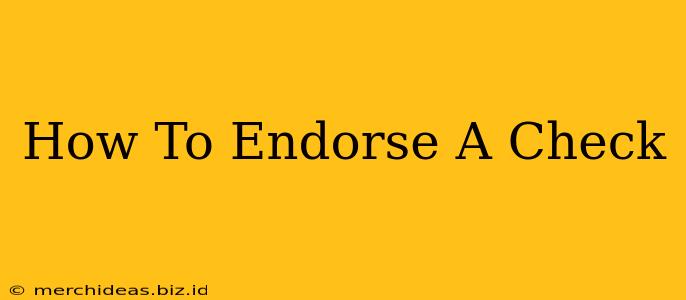Endorsing a check might seem like a simple task, but doing it correctly is crucial to ensure your funds are secure and you avoid any potential problems. This guide will walk you through the process, covering different endorsement types and offering tips to protect yourself from fraud.
Understanding Check Endorsements
Before we dive into the how, let's understand the why. An endorsement is your signature on the back of a check, essentially transferring ownership to someone else. Without a proper endorsement, the check cannot be cashed or deposited.
Why is endorsing a check important?
A proper endorsement acts as a legally binding confirmation that you are transferring the funds to the intended recipient. Without it, the check is considered incomplete and cannot be processed. This process safeguards both the payer and the payee, preventing unauthorized access to funds.
Types of Check Endorsements
There are several ways to endorse a check, each serving a different purpose. Choosing the right type depends on your needs and how you plan to use the check.
1. Blank Endorsement
This is the simplest form. You simply sign your name on the back of the check, exactly as it appears on the front. This makes the check payable to anyone who possesses it, so it's the least secure method and should only be used if you're immediately depositing the check or handing it directly to the person or business who will cash it.
How to: Sign your name clearly on the back of the check.
2. Restrictive Endorsement
This method offers more security. You write "For Deposit Only" followed by your signature and account number. This limits the check's use to deposit only into your specified account.
How to: Write "For Deposit Only" followed by your account number and then sign your name exactly as it appears on the front.
3. Special Endorsement
This type is used when you want to transfer the check to a specific person or entity. You write "Pay to the order of [Name/Entity]" followed by your signature. The new payee will need to endorse it before it can be cashed or deposited.
How to: Write "Pay to the order of [Name/Entity]" followed by your signature.
4. Qualified Endorsement
This endorsement protects you from liability if the check is subsequently dishonored (meaning the payer doesn't have sufficient funds). It's done by adding "Without Recourse" before your signature. This clarifies that you aren't responsible if the check bounces.
How to: Write "Without Recourse" followed by your signature.
Important Tips for Endorsing Checks
- Use a pen: Avoid pencils or other writing instruments that could be easily erased or altered.
- Sign clearly: Make your signature legible and identical to the one on the front of the check.
- Endorse only when ready: Don't sign the back of a check until you are prepared to deposit or cash it.
- Be mindful of your surroundings: Avoid endorsing checks in public places where others could observe your signature.
- Keep endorsed checks secure: Protect endorsed checks from theft or loss.
Troubleshooting Common Endorsement Issues
- Incorrect Signature: If your signature doesn't match the one on the front of the check, the check may be rejected.
- Missing Endorsement: An unendorsed check cannot be processed.
- Ambiguous Endorsement: Illegible or unclear endorsements can lead to rejection.
Following these guidelines will ensure a smooth and secure check endorsement process every time. Remember, attention to detail and security practices are paramount when handling financial transactions. By understanding the different endorsement types and following best practices, you can confidently manage your checks and protect your funds.
